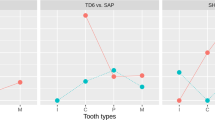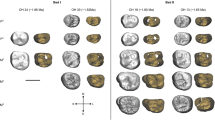Abstract
Enamel thickness has assumed unique importance in the debate about the hominid status of Ramapithecus, despite the fact that there is little agreement about the meaning of ‘thick enamel’ or the significance of enamel thickness for hominoid taxonomy1–19. My aim here is to evaluate the usefulness of enamel thickness and microstructure as characteristics for determining the relationships of the later Miocene hominoids, based both on a quantitative study of enamel thickness in extant hominoids and four species of later Miocene Sivapithecus (including ‘Ramapithecus’) and on scanning electron microscope analysis of enamel microstructure20. Four categories of enamel thickness are defined metrically here and have been related to enamel microstructure and developmental rates. Thin fast-formed (pattern 3) enamel represents the ancestral condition in hominoids; it increased developmentally to thick pattern 3 enamel in the great ape and human clade and that condition is primitively retained in Homo and in the fossil hominoid Sivapithecus (including ‘Ramapithecus’). Enamel thickness has been secondarily reduced in the African apes and also, although at a different rate and extent, in the orang-utan. Thick enamel, previously the most important characteristic in arguments about the earliest hominid, does not therefore identify a hominid.
This is a preview of subscription content, access via your institution
Access options
Subscribe to this journal
Receive 51 print issues and online access
$199.00 per year
only $3.90 per issue
Buy this article
- Purchase on Springer Link
- Instant access to full article PDF
Prices may be subject to local taxes which are calculated during checkout
Similar content being viewed by others
References
Simons, E. L. Postilla 57, 1–9 (1961).
Ciochon, R. L. & Corruccini, R. S. (eds) New Interpretations of Ape and Human Ancestry (Plenum, New York, 1983).
Ciochon, R. L. in New Interpretations of Ape and Human Ancestry, 783–843 (Plenum, New York, 1983).
Kay, R. F. Am. J. phys. Anthrop. 55, 141–152 (1981).
Kay, R. F. Proc. natn. Acad. Sci. U.S.A. 79, 209–212 (1982).
Kay, R. F., Int. J. Primatol. 3, 113–173 (1982).
Kay, R. F. & Simons, E. L. in New Interpretations of Ape and Human Ancestry, 577–624 (Plenum, New York, 1983).
de Bonis, L. in New Interpretations of Ape and Human Ancestry, 625–649 (Plenum, New York, 1983).
Schwartz, J. H. Nature 308, 501–505 (1984).
Zihlman, A. H. & Lowenstein, J. M. in New Interpretations of Ape and Human Ancestry, 677–694 (Plenum, New York, 1983).
Wolpoff, M. H. in New Interpretations of Ape and Human Ancestry, 651–676 (Plenum, New York, 1983).
Greenfield, L. O. in New Interpretations of Ape and Human Ancestry, 695–703 (Plenum, New York, 1983).
Andrews, P. & Tekkaya, I. Palaeontology 23, 85–95 (1980).
Andrews, P. & Cronin, J. E. Nature 297, 541–546 (1982).
Gantt, D. G. thesis, Washington Univ. (1977).
Ward, S. C. & Pilbeam, D. R. in New Interpretations of Ape and Human Ancestry, 211–238 (Plenum, New York, 1983).
Simons, E. L. & Pilbeam, D. R. in The Functional and Evolutionary Biology of the Primates, 36–62 (Aldine, Chicago, 1972).
Simons, E. L. J. hum. Evol. 5, 511–528 (1976).
Gantt, D. G. in New Interpretations of Ape and Human Ancestry, 249–298 (Plenum, New York, 1983).
Martin, L. B., thesis, London Univ. (1983).
Beynon, A. D. & Wood, B. A. J. dent. Res. 63, 505, abstr. 144 (1984).
Andrews, P. & Tobien, H. Nature 268, 699–701 (1977).
Boyde, A., thesis, London Univ. (1964).
Gantt, D. G., Pilbeam, D. R. & Steward, G. P. Science 198, 1155–1157 (1977).
Vrba, E. S. & Grine, F. E. Science 202, 890–892 (1978).
Boyde, A. & Martin, L. Anat. Embryol. 165, 193–212 (1982).
Boyde, A. & Jones, S. J. Anat. Embryol. 168, 211–226 (1983).
Martin, L. & Andrews, P. Cour. Forsch. Inst. Senckenberg 67, 25–40 (1984).
Martin, L. & Andrews, P. Primate Eye 18, 4–7 (1982).
Boyde, A. & Martin, L. in Tooth Enamel Vol. 4, 417–421 (Elsevier, Amsterdam, 1984).
Author information
Authors and Affiliations
Rights and permissions
About this article
Cite this article
Martin, L. Significance of enamel thickness in hominoid evolution. Nature 314, 260–263 (1985). https://doi.org/10.1038/314260a0
Received:
Accepted:
Issue Date:
DOI: https://doi.org/10.1038/314260a0
This article is cited by
-
Ordinaries 8
Journal of Bioeconomics (2022)
-
Earliest known human burial in Africa
Nature (2021)
-
The hidden structure of human enamel
Nature Communications (2019)
-
A new primate from the late Eocene of Vietnam illuminates unexpected strepsirrhine diversity and evolution in Southeast Asia
Scientific Reports (2019)
-
An early modern human presence in Sumatra 73,000–63,000 years ago
Nature (2017)
Comments
By submitting a comment you agree to abide by our Terms and Community Guidelines. If you find something abusive or that does not comply with our terms or guidelines please flag it as inappropriate.



